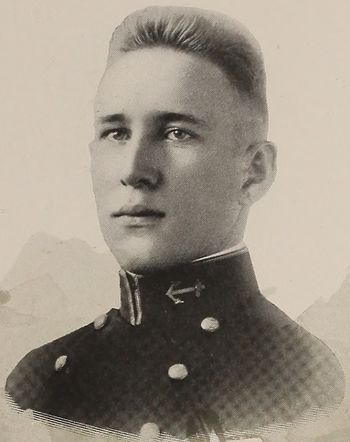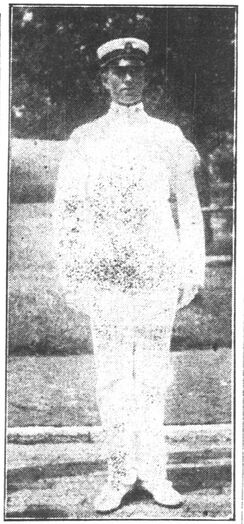FESTUS F. FOSTER, CAPT, USN
Festus Foster '19
Lucky Bag
From the 1919 Lucky Bag:
Festus Finley Foster
Topeka, Kansas
IF you have never seen this shining countenance contorted in an effort to expostulate with effervescent energy, you do not know Festus as he really is. Moreover, you have not heard "English as she is spoke." His love of preciseness and rhetorical expression have won for him the recognition of being that rara avis—a literary genius. The modes of expression of his ethereal spirit are many and varied; still, Festus has his share of the old Adam. For instance, Plebe year he was strong for the eradication of class distinctions and rates, while now he resents even the thought of such a thing.
Occasionally this scion of the What-Nots gets real devilish and commits some rash deed. Once, after great provocation, he was even heard to employ strong and sulphurous language. In spite of his youth and innocence he displayed a profound and intimate knowledge of all of the words and a majority of the combinations.
Among his other gifts Festus shines as a navigator. First Class cruise he shot another ship's truck-light instead of Vega and got a fix that turned out to be the true position of his ship. In the realm of athletics he shines as the wielder of a racquet, confounding his adversaries with his line as well as his line drives.
Festus is not only idealistic in the Bryanic sense, but he is also gifted with that gentleman's lingual ability.
"Literary aspirants should religiously eschew expressions of polysyllabic orthography."
Honors: One Stripe; Tennis Squad 4; Log Staff 3.
The Class of 1919 was graduated on June 6, 1918 due to World War I. The entirety of 2nd class (junior) year was removed from the curriculum.

Festus Finley Foster
Topeka, Kansas
IF you have never seen this shining countenance contorted in an effort to expostulate with effervescent energy, you do not know Festus as he really is. Moreover, you have not heard "English as she is spoke." His love of preciseness and rhetorical expression have won for him the recognition of being that rara avis—a literary genius. The modes of expression of his ethereal spirit are many and varied; still, Festus has his share of the old Adam. For instance, Plebe year he was strong for the eradication of class distinctions and rates, while now he resents even the thought of such a thing.
Occasionally this scion of the What-Nots gets real devilish and commits some rash deed. Once, after great provocation, he was even heard to employ strong and sulphurous language. In spite of his youth and innocence he displayed a profound and intimate knowledge of all of the words and a majority of the combinations.
Among his other gifts Festus shines as a navigator. First Class cruise he shot another ship's truck-light instead of Vega and got a fix that turned out to be the true position of his ship. In the realm of athletics he shines as the wielder of a racquet, confounding his adversaries with his line as well as his line drives.
Festus is not only idealistic in the Bryanic sense, but he is also gifted with that gentleman's lingual ability.
"Literary aspirants should religiously eschew expressions of polysyllabic orthography."
Honors: One Stripe; Tennis Squad 4; Log Staff 3.
The Class of 1919 was graduated on June 6, 1918 due to World War I. The entirety of 2nd class (junior) year was removed from the curriculum.
Loss
Festus was lost on March 3, 1945 when the aircraft he was aboard crashed at Brandon, France. He had been in Europe for perhaps only two weeks, having been temporarily assigned to the "U.S. Technical Mission Europe" since February 16.
Other Information
From researcher Kathy Franz:
Festus was on the debate team for Kansas High School. In December, 1913, he participated in the affirmative side for the Initiative and Referendum Question: Here’s to Valley and the I. & R. He also attended Topeka High School.
His father was a Congregational minister. His mother Lillian was an active club woman and was elected president of the First District Federation of Kansas in October, 1913.
His brother Paul (‘11) in May, 1914, was on the Utah which captured Vera Cruz. He was made temporary provost marshal under the government established by the marines, and later received a medal for distinguished service in the campaign. Brother Ralph was a Rhodes scholar at Oxford and was in London and Paris when German bombs were dropped on those cities. Ralph was on the Maloja when she was sunk. Brother Carrol H., also a Rhodes scholar, was an instructor in English at Annapolis in 1915.
From Find A Grave:
Captain, USN s/n 37282. Graduated from U S Naval Academy in the class of 1919. Son of Festus R. Foster and Jennie Lillian C. Howe. He was killed in an air crash bringing USO performers from England to France, according to information provided by contributor Dwight "Andy" Anderson. He married Beatrice Michelson, the daughter of physicist Alfred A Michelson, first American to win a Nobel Prize for the sciences. One daughter, Barbara, and one son, Jeremy. Beatrice died in an automobile accident in Hamilton, Loudoun County, Virginia, in December 1972.
Captain Festus F. Foster (NSN: 0-37282), United States Navy, was awarded the Legion of Merit (Posthumously) for exceptionally meritorious conduct in the performance of outstanding services to the Government of the United States during World War II.
Festus was a passenger on C-47A #43-48223 that was assigned to the 1403rd Base Unit, U.S. Army Air Force.
Service and burial information from USNA Register of Alumni and U.S. Rosters of World War II Dead, 1939-1945.
From the Naval History and Heritage Command:
Captain Foster was born on January 16, 1899, at Hennessey, Oklahoma. He attended the Topeka High School, Topeka, Kansas and entered the U.S. Naval Academy, Annapolis, Maryland, from Kansas in 1915, a member of the class of 1919, which graduated June 6, 1918. Graduated and commissioned Ensign, he advanced progressively through the various grades to the rank of Captain to rank from June 17, 1942.
Captain Foster had World War duty while a Midshipman, aboard the USS RHODE ISLAND from May 29 until August 22, 1917, and following graduation from the Academy in 1918, was assigned duty in the US ОКLАНОМА, operating withthe British Grand Fleet during the latter part of the war. He reported in September 1923 at the Postgraduate School, Annapolis, Maryland, for instruction in ordnance engineering, continuing his instruction under the cognizance of the Postgraduate School at the Navy Yard, Washington, D.C.; Ford Instrument Company, Long Island, New York; and at the University of Chicago, Chicago, Illinois, receiving the degree of Master of Science from the latter in 1926.
From June 1926 until April 1929, Captain Foster served aboard the USS NEW MEXICO, after which he had duty at the Naval Proving Grounds Dahlgren, Virginia. On August 1, 1931, he was assigned to the Bureau of Ordnance, Navy Department, Washington, D.C., serving there until December 1937, when he was ordered to the Navy Yard; Mare Island, California. From June 24, 1941 to January 30, 1942 he served as Inspector of Ordnance in Charge at the Naval Ordnance Plant, Centerline, Michigan, with additional duty as Naval Inspector of Ordnance, Pontiac Division, General Motors Corporation, Pontiac, Michigan and had further additional duty as Naval Inspector of Ordnance, Chrysler Corporation, Detroit, Michigan. In January 1942, he was relieved of the latter additional duty. He was again ordered to duty in the Bureau of Ordnance, Navy Department, and served in that assignment until October 1943, when he was detached and reported for duty at the Naval Proving Grounds, Dahlgren, Virginia. On February 16, 1945, he received orders to report at the U.S. Technical Mission Europe for temporary additional duty, and while in this assignment he was killed in a plane crash at Breancon; France on March 3, 1945.
In addition to the Legion of Merit (citation below), Captain Foster had the Victory Medal, Grand Fleet Clasp; the American Defense Service Medal and was enttitled to the American Area Campaign Medal and the World War II Victory Medal.
His wife was listed as next of kin.
Photographs
Legion of Merit
From the Naval History and Heritage Command:
For exceptionlly meritorious conduct in the performance of outstanding services to the Government of the United States as Inspector of Ordnance in Charge at the Naval Ordnance Plant, Centerline, Michigan, from December 1941, to January 1942; as Chief of the Guns and Mounts Section of the Research Division of the Bureau of Ordnance from January 1942, to October 1943; and as Ordnance Officer and Second in Command at the Naval Proving Grounds from October 1943, to February 1945. Demonstrating administrative ability and technical skill in each of these difficult assignments, Captain Foster rendered invaluable assistance in organizing and training, competent staffs to ensure a satisfactory quality of weapons, urgently needed for anti-aircraft protection for our Fleet. In addition, he furnished advice on intricate manufacturing procedures and inspection techniques to contracting corporations, thereby paving the way for the delivery of ordinance, material of the requisite, quantity and quality. His devotion to duty was in keeping with the highest traditions of the United States Naval Service.
The "Register of Commissioned and Warrant Officers of the United States Navy and Marine Corps" was published annually from 1815 through at least the 1970s; it provided rank, command or station, and occasionally billet until the beginning of World War II when command/station was no longer included. Scanned copies were reviewed and data entered from the mid-1840s through 1922, when more-frequent Navy Directories were available.
The Navy Directory was a publication that provided information on the command, billet, and rank of every active and retired naval officer. Single editions have been found online from January 1915 and March 1918, and then from three to six editions per year from 1923 through 1940; the final edition is from April 1941.
The entries in both series of documents are sometimes cryptic and confusing. They are often inconsistent, even within an edition, with the name of commands; this is especially true for aviation squadrons in the 1920s and early 1930s.
Alumni listed at the same command may or may not have had significant interactions; they could have shared a stateroom or workspace, stood many hours of watch together… or, especially at the larger commands, they might not have known each other at all. The information provides the opportunity to draw connections that are otherwise invisible, though, and gives a fuller view of the professional experiences of these alumni in Memorial Hall.
January 1919
January 1920
January 1921
July 1923
September 1923
November 1923
January 1924
March 1924
May 1924
July 1924
September 1924
November 1924
January 1925
March 1925
May 1925
July 1925
October 1925
January 1926
October 1926
January 1927
April 1927
October 1927
January 1928
April 1928
October 1928
January 1929
April 1929
July 1929
October 1929
January 1930
April 1930
October 1930
January 1931
April 1931
July 1931
October 1931
January 1932
April 1932
October 1932
January 1933
April 1933
July 1933
October 1933
April 1934
July 1934
October 1934
January 1935
April 1935
October 1935
January 1936
April 1936
July 1936
January 1937
April 1937
September 1937
January 1938
July 1938
January 1939
October 1939
June 1940
November 1940
April 1941

The "category" links below lead to lists of related Honorees; use them to explore further the service and sacrifice of alumni in Memorial Hall.
